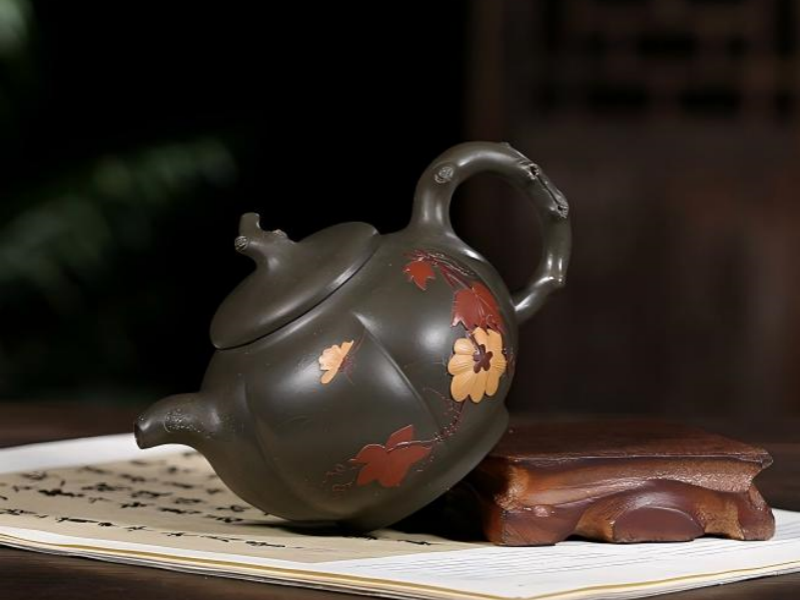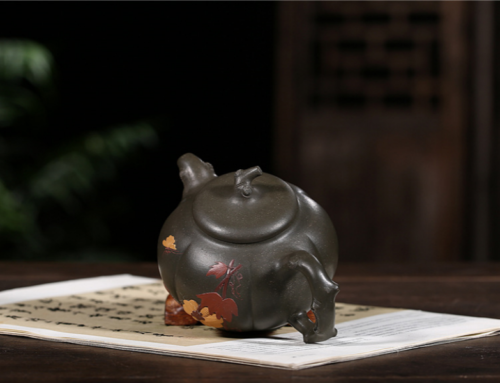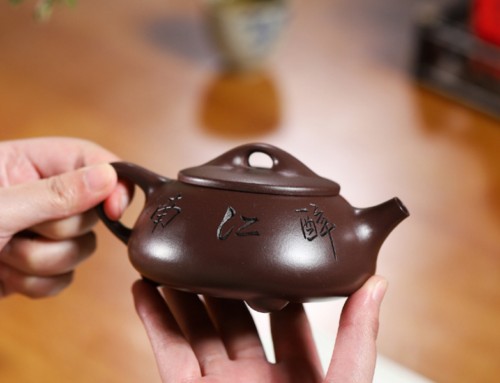Japanese Kyusu Asian Teapots: A Marriage of Tradition and Creation
Japanese Kyusu Asian Teapots encapsulate centuries of craftsmanship, tradition, national pride and design innovation. Japanese kyusu teapots have long been a cornerstone of Japanese traditional tea culture. They offer a unique way of brewing, pouring and serving tea that elevates the flavor and aroma of the brew. If you’re someone who appreciates Japanese cultural traditions, someone who’s looking to learn or someone who enjoys drinking tea, understanding the value of Kyusu pots introduces you to the grandeur of Japanese cultural heritage and modern design legacy.
What is an Kyusu teapot? A Kyusu is essentially a small, usually side-handled (although there are also top-handled kyusu) Japanese teapot for brewing Japanese green tea. Made from clay, porcelain, and even glass, Kyusu teapots are designed to enhance all the senses that tea drinking brings to tea lovers. They are celebrated for their beauty, ergonomics and ability to showcase the delicate nuances of tea flavours.
What is special about Kyusu teapots? More than just an accessory to prepare tea, the Kyusu teapot embodies the Japanese mindset of mindfulness and harmony. Each Kyusu teapot is a personal expression of the craftsman’s eye for detail and unique artistry. It is often a blend of traditional techniques with new, creative additions to adapt to modern lifestyles. Kyusu teapots are a form of art! The story of each Kyusu teapot continues through the user, deepening in its Japanese roots.
This article will explore Kyusu teapots in greater depth by covering the history of Kyusu teapots, unique shapes, materials, brewing methods, and modern innovations. We will also provide tips for choosing a Kyusu teapot to help ensure that you have everything you need to start your tea journey.
History and Tradition of Kyusu Teapots
The Origins of Kyusu Teapots
The history of Kyusu teapots goes back centuries and is closely intertwined with the history of Japanese tea. Whilst the literal translation of the word Kyusu from Japanese is simply “teapot”, the designs of the Kyusu set them apart from other teapots around the world. Kyusu teapots were first crafted in the Edo period (1603–1868), an era that was flourishing with incredible art and craftsmanship in Japan. Artisans had started crafting Kyusu teapots specifically for brewing Japanese green tea, Shizuoka Yuki no Sasayaki Sencha and Chiran Kasuga no En Gyokuro, to name just a few, which were also beginning to rise in popularity during this time.
One of the major turning points in the history of Kyusu teapots includes the invention of Tokoname ware. Originating in Tokoname City in Aichi Prefecture, Tokoname pottery ultimately became a synonym for clay teapots that enhanced the taste of tea. Such teapots were hallmarked for their function, heat insulation and enhanced and efficient extraction of umami characteristics of green tea. Known as one of the “Six Ancient Kilns” of Japan, Tokoname ware teapots are as respected now as they were then.
Role in Japanese Tea Culture
Kyusu teapots hold a revered position in Japanese tea culture, particularly in the preparation and presentation of tea. In contrast to Western tea culture, which often focuses on convenience and expediency, Japanese tea culture emphasizes mindfulness, precision, and harmony. The Kyusu teapot embodies these principles, allowing tea drinkers to engage in a deliberate ritual that enhances the overall tea-drinking experience.
For example, using a Kyusu teapot to brew tea requires precision in temperature and steeping time to extract full flavor from the tea leaves. Traditionally, the Kyusu teapot is crafted with a side handle that is ergonomic, allowing the user to pour effortlessly, ensuring minimal disruption of the tea, and achieving a proper pour. Additionally, making a tea in a Kyusu teapot is often meditative, creating the opportunity for person porcelain to slow down and enjoy tea thoughtfully.
Kyusu teapot is often paired with delicate cups and trays on a traditional Japanese tea ritual, which will help to create a pleasant sensory experience visually and sonically. Therefore, Kyusu teapot has evolved from being a tools for tea-drinking into a collectors item that is treasured for its cultural significance. Many of these collectors are always scouring for vintage or artisan Kyusu teapot.
Anatomy and Varieties of Kyusu Teapots
Unique Design Components
Kyusu teapots are instantly identifiable due to their unique design elements. The characteristic that stands out the most is the side handle, or “Yokode.” This feature is not only aesthetically pleasing but also highly functional. It allows for a smooth pouring action without needing the user to twist their wrist. The side handle is particularly handy when serving tea to several guests, as it offers better control and reduces the risk of spilling.
Other designs include an inbuilt mesh strainer, usually made from stainless steel or ceramic, which prevents the leaves from getting into the cup, and a small opening at the spout to let liquid flow out while holding in the leaves. Since it is included in the opening it is less noticeable than the external mesh, despite the fact that they both serve the same purpose.
The spouts of Kyusu teapots are designed to be drip-free which results in a clean and minimal pouring flow and the lids fit well to prevent heat loss, a key component of the brewing process. These two aspects of the Kyusu teapot’s design make the Kyusu teapot equal parts form and function.

Types of Kyusu Teapots
Kyusu teapots are available in a number of different styles, with each one appealing to different tastes and brewing styles. The most popular types of kyusu teapots include these:

For every type of Kyusu teapot, an individual aspect of the Japanese tea culture is expressed, allowing the tea lover to decide on which one is most suitable for their desired brewing technique and visual preference.
Clay and Porcelain Kyusu Teapots
The materials of construction of Kyusu teapots strongly define their functionality and aesthetics. The highly regarded material is the Tokoname clay from Tokoname City in Japan. This iron-rich high-quality clay lightly reacts with the tea to draw out its natural deliciousness. The high iron content also interacts with the tannins in the tea to remove some of the astringency of green tea. Over time, the clay absorbs some of the tea oils from each brew, resulting in a seasoned Kyusu that adds enhanced flavor with each pot of tea made. It’s generally left unglazed, and its porous nature allows the clay to breathe, adding to the aroma of the delicate Japanese tea scent.
Porcelain Kyusu: Compared to clay, porcelain has a smoother texture and finish. Unlike clay, porcelain is non porous and therefore much better for brewing lightly-fermented or subtle-flavour teas (e.g. Gyokuro). Porcelain Kyusu often display the craft of Japanese potters and are commonly decorated in ornate designs and glazes.
Modern Materials
While Kyusu teapots were traditionally made from clay or porcelain, modern Kyusu teapots may also be made from alternative materials such as glass or metal. As glass is a transparent material, glass Kyusu teapots have the advantage of allowing tea drinkers to see the infusion of the tea take place and to enjoy watching the tea leaves unfurl.
Metal Kyusu are typically made from stainless steel. They are robust and allow for a more modern visual aesthetic. It is considered particularly useful for keeping temperatures high and their appearance works well in a contemporary kitchen. Metal kettles are quite rare however, as they can change the flavour of the tea.
These Kyusu teapots combine traditional and modern materials to provide a variety of options to satisfy every tea drinker.

Brewing Tea in Kyusu Teapots
How to Brew Tea
Brewing tea in a Kyusu teapot is an elegant yet simple process that brings out the best in your favourite Japanese green tea. Follow these steps to brew the perfect cup:
The precision and attention to detail involved in brewing the perfect pot of Kyusu ensures that the delicate Japanese green tea’s flavor is preserved and imbibed with.
Best Teas to Brew
As kyusu teapots are specially designed for brewing Japanese teas, they’ll perform best when used to their intended purpose:

The Kyusu unleashes the full power of these teas and brings a satisfaction to tea drinking that is hard to beat.
Modern Innovations in Kyusu Teapots
Tradition Meets Technology
While Kyusu teapots are rooted in centuries of tradition, modern artisans have embraced innovation to adapt these iconic teapots to contemporary lifestyles. One of the most notable advancements is the introduction of smart Kyusu teapots. These teapots feature built-in temperature control systems, allowing users to precisely heat water to the ideal temperature for brewing different types of tea. With digital interfaces and automatic timers, smart Kyusu teapots bring convenience to the art of tea brewing while maintaining the essence of Japanese craftsmanship.
Another major innovation includes multi-material designs. Hybrid kyusu, such as those with glass lids, have appeared on the market. With these design, users can closely inspect the state of their tea during brewing while still enjoying the flavor enhancing properties of Tokoname clay. Multi-material kyusu expand aesthetic choices, offer benefits not found in clay kyusu, and ensure that kyusu continue to have a place in modern kitchens.
Rethink Materials the Sustainable Way
Today, more Kyusu potters are using sustainable materials in response to numerous environmental issues. It results that a growing number of artisans are applying sustainable clay and natural glazes to Japanese teapots. In addition, energy efficient ceramic kilns are introduced at small to large manufacturers throughout Japan to save carbon foot prints (firing energy).
In some Kyusu designs, you’ll also find recycled materials, with some teapots using recycled metal or glass pieces. These innovations not only protect the Earth, they also provide unique textures and patterns for the teapots, making them even more aesthetically attractive. By using sustainable practices, Kyusu makers are making sure that their craft is sustainable in the long run too.
Customization and Personalization
Today’s tea drinkers are more focused on personalizing their tea accessories than ever before, and Kyusu teapots have not escaped this trend. Some craftsmen now offer personalized Kyusu teapots and buyers can choose the materials, colors, and designs. Personalized engravings, hand-painted motifs, bespoke shapes, you name it; there are many ways Kyusu teapots can be customized.
Your choice of a Kyusu teapot can be completely unique to you, whether you prefer a Tokoname-style teapot or prefer a modern glass hybrid.
Guide to Buying a Kyusu Teapot
What to Consider When Buying
When shopping for a Kyusu teapot, you need to consider a few factors that ensure you choose the perfect option for your tea drinking needs. Here are essential factors to consider:

By considering these factors, you’ll be able to choose a Kyusu teapot that aligns with your brewing habits and aesthetic preferences.
Where to buy Kyusu teapots
Due to the history and amazing benefits of the Kyusu teapot, many imitations exist on the market today. Thus, before buying one, make sure to do your research. Here are the best places to find authentic Kyusu teapots:

Comparison with Other Asian Teapots
Kyusu teapots differ from other teapots in Asian tea cultures. Here’s a summary:
| Feature | Japanese Kyusu Teapots | Chinese Yixing Teapots | Korean Onggi Teapots |
|---|---|---|---|
| Material | Clay, porcelain, glass | Porous clay | Ceramic |
| Handle Style | Side, top, rear | No handle | Rear handle |
| Best Tea Pairing | Green tea | Oolong tea | Fermented tea |
| Cultural Significance | Tea ceremonies | Gongfu tea brewing | Everyday tea brewing |
Kyusu teapots are best for brewing green tea. Many people like to use a kyusu teapot because of the way they’re designed, their ergonomic capabilities, and strainers that enhance drinking green tea more than other types of teapots.
Conclusion
Japanese Kyusu Asian Teapots blend tradition with modernity, combining centuries-old craftsmanship techniques with contemporary innovations that cater to the demands of modern tea enthusiasts. From their Tokoname clay pottery origins to their multifunctional uses in Japanese tea rituals, Kyusu teapots are more than a traditional and functional brewing vessel—packed with cultural significance, mindfulness, and artistry.
Ranging from side-handled Yokode teapots, to modern day hybrid teapots. Using materials from clay, to porcelain to glass. Kyusu teapots can be both practical and stunning, combined with the ritualised brewing process it allows, tea drinkers to enjoy the subtle tastes and enchanting aromas of Japanese green teas (such as Sencha and Gyokuro) to the full extent.
Plus, with new technologies in sustainable materials, customization, and smart features, Kyusu are constantly evolving and innovating while preserving their cultural origins. Whether you choose to brew tea in a traditional Kyusu teapot or in a more contemporary way, a Kyusu teapot is a perfect opportunity to indulge in Japanese tea culture in all its meditative brewing and timeless authentic beauty.
As you embark on your quest to find the perfect Kyusu teapot, remember the key to authenticity and quality. Whether you choose the traditional Tokoname clay style or the modern glass hybrid, each Kyusu teapot is a piece of Japanese craftsmanship and a story to tell. Let Kyusu teapots inspire your tea rituals and the deeper cultural significance of tea in Japan.












